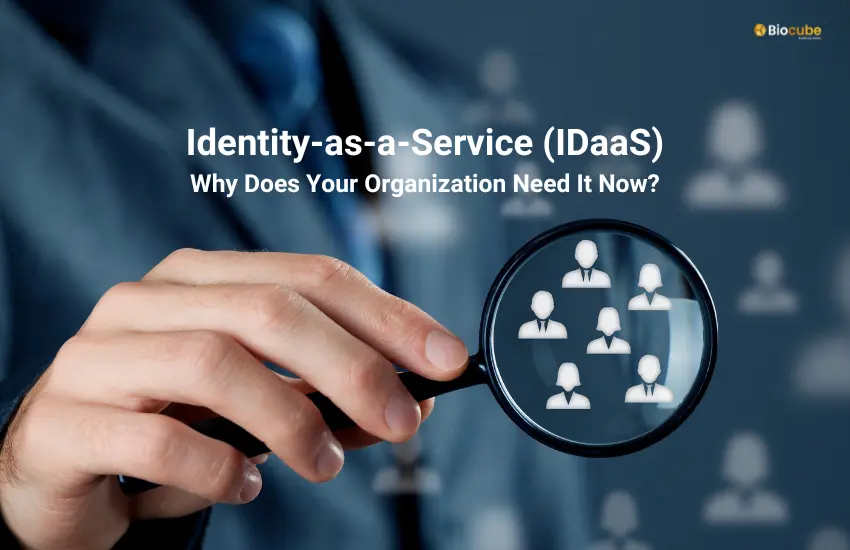
Identity-as-a-Service (IDaaS) is a cloud-based solution that connects users to their identity-managed services. It has become a necessary tool as it is upgrading the security & convenience of organizations in multiple ways.
Safeguarding accounts using biometrics like face, voice, or fingerprints has become a common new-age practice. The transition was smooth but came with many drawbacks. Last month, the Daily Mail reported that a 34-year-old man in Brazil took loans using a mobile banking app by capturing and plastering pictures of people on a dummy. The man was able to bypass the bank’s facial recognition technology to log into the accounts. Such instances have become a common problem for stakeholders in multiple industries.

The need of the hour is to incorporate a secure and convenient solution that doesn’t get easily manipulated by impersonation, tampered fingerprints, or manipulated voices. Identity-as-a-Service (IDaaS) built with passive liveness detection, multi-parameter analysis, 1:1 and 1:N matching, and other capabilities can significantly help achieve such results.
3 Significant Reasons to Adopt IDaaS in Your Organization
Liveness Check
The São Paulo Civil Police managed to apprehend the criminal spoofing faces to gain account access; however, many around the globe still remain at large. The threat of unwarranted account access using contactless biometrics like face or voice can be revoked by using passive liveness detection.
The passive liveness detection technology helps distinguish a real person from a fake. Biocube has tested its in-house tech using face prints, 2D/3D models, and deep fake AI, to avoid instances of bypassing access.
The tech makes the user’s life more convenient by dismissing the need for capturing gestures or mimicking pictures or gifs, and uploading the images/videos. It can be implemented during the onboarding, access, and authentication processes.
Secure and Contactless SSO
Passive liveness checking is one method that makes contactless biometrics more trustworthy. Biometric Single Sign-On (SSO) technology can also be connected with Anti-Money Laundering (AML), Politically Exposed Persons (PEPs), sanctions checks, and other Know Your Customer (KYC) checklists.
As a result, it acts as an antispoofing mechanism and notifies authorities of persons on the watchlist. The contactless SSO process even prevents duplication of digital identities. As a result, the chances of identity fraud decrease significantly. The additional advantage of deduplication is that the organization complies with the government’s guidelines to safeguard user data.
It also eliminates the need to carry RFID or chip cards and reduces the risk of criminal penetration into premises. The end user can conveniently access accounts using contactless and spoof-free biometric authentication technology using a regular smartphone, tablet, desktop, or laptop camera.
Supports More Than One Contactless Biometric
Identity-as-a-Service offers the capability to store more than one biometric characteristic on a secure data server. Biocube’s IDaaS encompasses random biometric authentication checks to decrease the risk of identity fraud within the app or web link and protects it with AES 256 encryption.
Unlike other standard IDaaS solutions, Biocube offers next-gen protection that ensures the genuineness of the end user by putting a barrier against criminals that use deep fakes or other similar manipulation methods.
Implementing more than one factor of authentication makes it more challenging for criminals to access accounts, as the characteristics of a person’s biometrics stored on the database need to match more than once. The contactless nature also eliminates the risk of duplicating a physical fingerprint or thumb impression.
Conclusion
The reasons for adopting Identity-as-a-service (IDaaS) in your business range beyond the three listed above. For example, face technology can help mark employee attendance and supplement smooth visitor access.
Similarly, the use of this technology saves organizations from recurring high capital expenditures on upgrading, replacing, or installing hardware. Moreover, it reduces instances of manual intervention for granting access at checkpoints.
So, the two significant advantages of IDaaS can be jotted down as enhancements in security and convenience at multiple levels. Using biometrics such as two-factor authentication (2FA) or Mutli-factor authentication (MFA) removes the threat of account hacking due to a lack of password hygiene.
